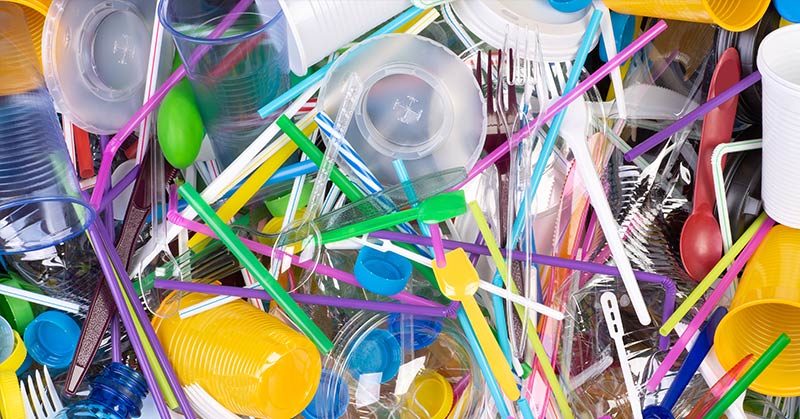Plastic pollution is one of the biggest issues facing our environment. Sadly, the problem is only getting worse. In 1950, humans produced about 2.3 million tonnes of plastic annually. By 2015, that number had increased to 448 million tonnes. Experts estimate that production will double by 2050 [1]. This is why Canada’s new plastic ban is worth talking about.
Of course, when you throw your plastic bag or water bottle in the garbage, it doesn’t just disappear. It has to go somewhere, and more often than not, that “somewhere” is our oceans. Currently, about eight million tonnes of plastic waste ends up in our oceans every year [1].
The vast majority of what’s left sits in landfills, leaching chemicals into our soil and groundwater.
In June 2019, the government of Canada announced a plan to ban single-use plastics as early as 2021 [2]. Today, the government has renewed that promise. A Canada-wide plastic ban is set to begin, starting with plastic bags, straws, and cutlery.
Canada Plastic Ban
In October 2020, a little over a year after committing to a country-wide plastic ban by 2021, Environment and Climate Change Minister Jonathan Wilkinson announced a new list of plastics being put on the banned list.
These products include plastic grocery bags, stir sticks, straws, six-pack rings, cutlery, and food containers that are made from hard-to-recycle plastics. This is the next step in the federal government’s plan to achieve zero plastic waste in the country by 2030.
According to the Liberal government, these plastics are consistently found in the environment, but they have readily available alternatives. Wilkinson admitted that he knows it is hard to leave the grocery store without some of these items, but stated that change has to happen.
He added that when the ban comes into effect, retailers will be providing customers with alternatives.
“At the end of the day, Canadians expect us as governments to take action on an issue that they know is an important one… and to be honest with you, Canadians are far ahead of their governments on the plastic issue they’ve been demanding this kind of action for a long time,” Wilkinson said [3].
The government is welcoming feedback on the plan on a discussion paper that will be available until December ninth. The regulations will not come into effect until the end of 2021.
Read: Kids Don’t Need Plastic Junk. So, Please Stop Buying It.
Canada Plastic Ban and COVID-19
Before the COVID-19 pandemic hit, Canadians were generally supportive of efforts to reduce plastic pollution in their country. By the summer of 2020, however, that support began to wane.
A report conducted by Dalhousie University’s Agri-Food Analytical Science Lab found that since the pandemic began, support for a ban on single-use plastics dropped from seventy percent approval to 58 percent [4].
The report found that more Canadians were favoring health and safety protections of plastics over reusable alternatives. It also determined that fifty percent of consumers had become more price-conscious amidst nation-wide job losses. Recognizing that reusable alternatives typically cost more, many respondents said regulations surrounding single-use plastics should be put off until the pandemic ends [4].
Understanding this, the federal government says that the ban will not include PPE, or other plastics used in the medical industry. They are, however, trying to come up with a plan to reduce the impact these products have on the environment.
“We’re also investigating solutions to recycle PPE where it is safe to do so, and options to make some of the PPE biodegradable,” Wilkinson said [3].
Reaction from Canadian Businesses
In light of the COVID-19 pandemic, many businesses have had to shift from in-house dining to takeout and delivery only. This, of course, has increased the amount of single-use plastics people are using and throwing away.
Wilkinson explained that the government chose these specific items because there are already alternatives that are readily-available and affordable. He noted that in the context of takeout, the government’s main focus is polystyrene, which is difficult to recycle.
“Many, many of the restaurants that do takeout have already transitioned away from polystyrene to other forms, whether it’s cardboard or different forms of paper, which are recyclable,” he added [3].
Business owners, however, are concerned about the financial impact this plastic ban might have. Small business owners are particularly worried. Canadian Chamber of Commerce’s Aaron Henry voiced these concerns in a public statement:
“Canadian businesses recognize the significant benefits of alternatives to single-use plastics and the importance of bolstering Canada’s circular economy. However, Canada’s approach must go beyond surface issues like bans, to address the critical infrastructure required to deliver on the positive benefits for the environment.” [3]
He added that in the current climate, many businesses are counting every dollar. Any extra costs, then, could be the difference between remaining open, or closing for good. He also noted that the policy does not address the current “fragmented approaches” to disposing consumer products.
An Aggressive Stance Against Plastic
The new policy also includes a proposal to establish requirements for the amount of recycled material in products and packaging. The federal government believes that this will encourage more investment in recycling infrastructure and technological innovation.
The hope is that experts will figure out ways to extend the life of plastic materials. This way, they will stay in the economy and out of the landfills. Wilkinson also pledged two million dollars to go to fourteen Canadian-led zero plastic waste projects.
In a few days, the Canadian government will be proposing to add “plastic manufactured items” to the list of regulated products under the Canadian Environmental Protection Act of 1999. There are also several other items on this list, including greenhouse gasses [3].
While plastic pollution is only one of the problems facing our environment, it is crucial that we take action against it. The Canada plastic ban will, hopefully, encourage other countries to also take a more aggressive stance against it.
- https://www.nationalgeographic.com/environment/habitats/plastic-pollution/
- https://www.ctvnews.ca/canada/canada-moving-on-single-use-plastics-ban-but-will-determine-products-later-1.4459274?cache=yes%3FclipId%3D89926%3FautoPlay%3Dtrue
- https://www.ctvnews.ca/climate-and-environment/canada-banning-plastic-bags-straws-cutlery-and-other-single-use-items-by-the-end-of-2021-1.5135968
- https://www.dal.ca/sites/agri-food/research/plastic-food-packaging–before-and-after-covid-19.html

